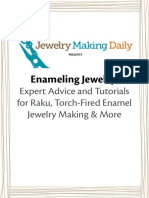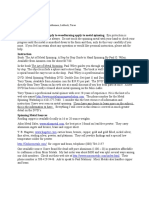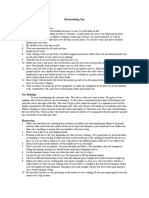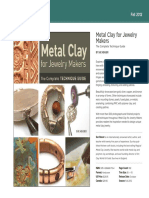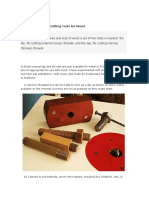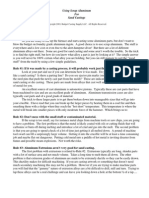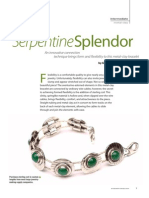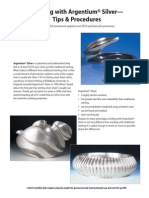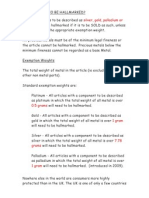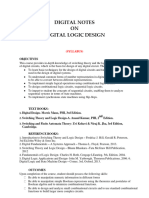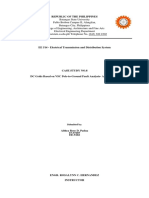Professional Documents
Culture Documents
Decorative Finishes: Imogen Waitt © May, 2010
Decorative Finishes: Imogen Waitt © May, 2010
Uploaded by
api-132751606Original Description:
Original Title
Copyright
Available Formats
Share this document
Did you find this document useful?
Is this content inappropriate?
Report this DocumentCopyright:
Available Formats
Decorative Finishes: Imogen Waitt © May, 2010
Decorative Finishes: Imogen Waitt © May, 2010
Uploaded by
api-132751606Copyright:
Available Formats
1 DECORATIVE FINISHES FORGING: Try using a selection hammers to create marks into your work.
This is a great way to add different textures. You can also use doming punches to create dimples in your work. You are spreading the metal and the edges of your work will move. This looks good, but if you want a straight edged finish, simply file your work smooth at the end. It is possible to buy or make decorative punches in star patterns, hatched patterns, wave patterns etc. Remember to keep annealing your work if the metal is soft it accept the hammer blows better and the pattern will be deeper and will ensure you do not split the metal as it work hardens. Make sure your hammer face is well polished before you start. Spending time getting your tools ready will pay off in the end. Any marks from an uneven hammer will be transferred onto the metal. This surface finish is best polished in a barrel polisher or with a soft wire brush, as a traditional polishing motor will reduce the effect of the hammer blows.
INLAYING Traditional inlaying can be tricky to master. It is necessary to cut a triangular groove into your metal and then hammer in the different metal that will form the inlay. The metal does not need to be soldered.
Imogen Waitt
May, 2010
2 This is a non-traditional alternative. Create a channel using a graver, saw, file or drill bit. Then feed the metal to be inlayed into the groove. Solder using small pallions placed at intervals along the inlay. After quenching and annealing, pass the metal through a rolling mill, wedge it in between protective metal plates and squeeze in a vice, or finally, put a protective plate over the piece of work and hit with a hammer.
OVERLAY USING SWEAT SOLDERING TECHNIQUES.
This example shows smaller and smaller stars sweat soldered one on top of the other. Layers can be built up using silver, gold, brass or copper to add interest.
GRANULATION Make small balls of silver or gold using your old scraps of metal. Simply make a dent in a piece of charcoal and melt the metal until it forms a rolling red hot ball. Once annealed they can be soldered or fused onto Imogen Waitt May, 2010
3 your work. It may help to file a small area of the ball flat to aid soldering.
DRILLING Interesting effects can be achieved by simply drilling into the metal. Either drill part way through and oxidise the metal, then polish off any unwanted black areas, or drill all the way through so that light/skin can
show through. To oxidise silver add 1 square cm of Potassium Sulphate to 1 pint of boiling water (or follow the instructions on a proprietary brand) and immerse for about 30 seconds. Dont leave it in too long as the end result will be flaky. Remove and rinse, then polish off any unwanted black with fine emery paper. The smell is simply dreadful, so make sure you ventilate well and do not inhale whilst leaning over the pan. To colour brass or copper you can use a solution of 4 parts ammonia and 1 part vinegar, mixed into damp sawdust or rolling tobacco. Leave it overnight at least, longer if possible. The result should be an attractive green patina on brass and a reddish blue on copper. Coat with varnish or lacquer to protect it AMMONIA SHOULD BE USED WITH CAUTION
Imogen Waitt
May, 2010
4 AND NEVER INHALED. PLEASE FOLLOW THE SAFETY INSTRUCTIONS ON THE BOTTLE.
This example is one I make regularly. I use a mixture of granulation and sweat soldering stars and pieces of fine wire to make the star trails. I use a mixture of sterling silver and yellow gold. The star trails can be soldered entirely to the back plate, or partially soldered by the star and raised up to gain a more 3-D effect.
Simple curls and swirls are also very effective.
Imogen Waitt
May, 2010
WIRE BRUSHES Steel or brass brushes can be used to get an subtle frosted effect. You will need to get out all your scratches in the usual way first.
SANDING BLOCKS Rub the sanding block in one direction only over the metal.
STEEL BURRS By dancing a steel burr (attached to your pendant drill or Dremmel ) over the surface of your metal you can etch patterns or effects onto the surface. There are numerous different burrs to choose from and each will give you a different finish.
Imogen Waitt
May, 2010
You might also like
- As Long As The Lemon Trees Grow: Zoulfa KatouhDocument4 pagesAs Long As The Lemon Trees Grow: Zoulfa KatouhErnawati -No ratings yet
- Magical Metal Clay: Amazingly Simple No-Kiln Techniques For Making Beautiful AccessoriesFrom EverandMagical Metal Clay: Amazingly Simple No-Kiln Techniques For Making Beautiful AccessoriesRating: 4 out of 5 stars4/5 (4)
- Enameling Jewelry Free EbookDocument22 pagesEnameling Jewelry Free EbookAwo Òkànràn DuuruNo ratings yet
- Basics of Jewelry MakingDocument13 pagesBasics of Jewelry Makingtherobroy81% (16)
- 0511 JMD-Enameling PDFDocument12 pages0511 JMD-Enameling PDFPaul Blythe Sr.67% (3)
- WC5 Parts Fabrication: Author: J. RandleDocument48 pagesWC5 Parts Fabrication: Author: J. RandleCristian Silva100% (1)
- LACP Fiberhome OLTDocument5 pagesLACP Fiberhome OLTOscar MartinezNo ratings yet
- SmithingDocument8 pagesSmithingapi-132751606No ratings yet
- Whimsical Whisks EarringsDocument3 pagesWhimsical Whisks EarringsJill Krahling100% (1)
- Gemstone Settings BLAD WebDocument8 pagesGemstone Settings BLAD WebInterweave75% (16)
- How To Make A Ring With Bezel SettingDocument5 pagesHow To Make A Ring With Bezel Settingmobsivac100% (3)
- Soldaduras PlatinoDocument10 pagesSoldaduras PlatinoTaller Rupay AntüNo ratings yet
- Making Your Own Jewelry Like A ProDocument40 pagesMaking Your Own Jewelry Like A ProNadia Oliphant-Momplè100% (2)
- Keum BooDocument3 pagesKeum Booapi-1327516060% (1)
- CopperbandringDocument2 pagesCopperbandringapi-250295080No ratings yet
- Metal Spinning HandoutDocument4 pagesMetal Spinning Handoutmike vidalNo ratings yet
- Black and White RibbonsDocument4 pagesBlack and White RibbonsVivian M. Rosario Santos100% (1)
- Soldering Irons: Choosing A Soldering IronDocument10 pagesSoldering Irons: Choosing A Soldering Irondrew_pearNo ratings yet
- Blacksmithing TipsDocument3 pagesBlacksmithing TipszironidNo ratings yet
- 14 JOINING ProcessesDocument17 pages14 JOINING ProcessesAlfred KuwodzaNo ratings yet
- Enameling JewelryDocument22 pagesEnameling JewelryPilar Andreo100% (3)
- Metal Clay Jewelry EbookDocument21 pagesMetal Clay Jewelry Ebook110802100% (2)
- Estrella de MoravianDocument21 pagesEstrella de MoravianclannecchNo ratings yet
- 0512 Cuttlebone PendantDocument0 pages0512 Cuttlebone PendantBASSANTESSAM90100% (1)
- ESTE ES Makume EsteeeeeeeeeDocument12 pagesESTE ES Makume EsteeeeeeeeeJoyasLoniNo ratings yet
- The Art and Science of Soldering: How We Do SolderingDocument3 pagesThe Art and Science of Soldering: How We Do SolderingchchuanNo ratings yet
- Jewelry Making for Beginners: 32 Projects with MetalsFrom EverandJewelry Making for Beginners: 32 Projects with MetalsRating: 4 out of 5 stars4/5 (2)
- 0511 JMD-EnamelingDocument12 pages0511 JMD-EnamelingFlavia A. Plumi100% (2)
- Basics of SolderingDocument4 pagesBasics of SolderingNAIR KRISHNA RAVEENDRAN100% (2)
- Basic Welding TermsDocument43 pagesBasic Welding TermsmailbkraoNo ratings yet
- Basic Silver SmithingDocument15 pagesBasic Silver SmithingPhotoArtist100% (1)
- 13 Beaten MetalworkDocument10 pages13 Beaten MetalworkAlfred Kuwodza100% (1)
- Soldering BeginnersDocument5 pagesSoldering Beginnersapi-132751606No ratings yet
- MCJM F12 BLAD WebDocument2 pagesMCJM F12 BLAD WebInterweaveNo ratings yet
- Finishing Techniques - Steven JacobDocument1 pageFinishing Techniques - Steven Jacobmajope1966No ratings yet
- Tips For Drilling Holes in MetalDocument18 pagesTips For Drilling Holes in MetalVacco Valdez CoolingNo ratings yet
- Experiment No 9Document3 pagesExperiment No 9frebytony2006No ratings yet
- Thread Cutting Tools For WoodDocument23 pagesThread Cutting Tools For WoodGermanHund100% (1)
- SolderingDocument4 pagesSolderingv sharvan kumar asst.prof(mech)No ratings yet
- Soldering - TLEDocument2 pagesSoldering - TLELady StaAnaNo ratings yet
- Wood ThreadDocument23 pagesWood Threadroberto_belyz100% (1)
- How To Weld Galvanized SteelDocument14 pagesHow To Weld Galvanized SteelbveNo ratings yet
- The Wireworkers Companion BLADDocument1 pageThe Wireworkers Companion BLADInterweaveNo ratings yet
- Robotics SolderingDocument3 pagesRobotics SolderingLaurice CabotajeNo ratings yet
- Bronze NeedleDocument6 pagesBronze Needlejan skalaNo ratings yet
- Basic Pewter Casting in SoapstoneDocument8 pagesBasic Pewter Casting in SoapstoneAnton Van AtenNo ratings yet
- Wooden Gear Clocks UK: Build Manual For "Clockerel" Electromechanical Wooden Geared ClockDocument25 pagesWooden Gear Clocks UK: Build Manual For "Clockerel" Electromechanical Wooden Geared ClockJosé OrdoñezNo ratings yet
- Silver Jewellery Making For Absolute Beginners Free Course Notes PDFDocument13 pagesSilver Jewellery Making For Absolute Beginners Free Course Notes PDFKhasheena Roberts100% (1)
- How To Solder Silver - 8 Steps (With Pictures) - WikiHowDocument3 pagesHow To Solder Silver - 8 Steps (With Pictures) - WikiHowtigerlo75No ratings yet
- Rust Bluing TutorialDocument9 pagesRust Bluing TutorialStefan Badica100% (1)
- BurrDocument9 pagesBurrOmsri VinashaNo ratings yet
- Scrap Metal Sources:: Using Scrap Aluminum For Sand CastingsDocument2 pagesScrap Metal Sources:: Using Scrap Aluminum For Sand CastingsAnonymous mKdAfWifNo ratings yet
- Foundry Manual02Document82 pagesFoundry Manual02Mohammad Namazi100% (2)
- Serpentinesplendor: An Innovative Connection Technique Brings Form and Flexibility To This Metal-Clay BraceletDocument4 pagesSerpentinesplendor: An Innovative Connection Technique Brings Form and Flexibility To This Metal-Clay BraceletDetalles Isabella100% (1)
- P-38 With Metal FoilDocument6 pagesP-38 With Metal FoilErisie100% (1)
- Working With Argentium Silver Tips Procedures IsDocument12 pagesWorking With Argentium Silver Tips Procedures Is4U6ogj8b9snylkslkn3n100% (1)
- How to Enamel: Being a Treatise on the Practical Enameling of Jewelry with Hard EnamelsFrom EverandHow to Enamel: Being a Treatise on the Practical Enameling of Jewelry with Hard EnamelsNo ratings yet
- Ch-5, COMPOSITION, CARE & CLEANING OF DIFFERENT SURFACEDocument26 pagesCh-5, COMPOSITION, CARE & CLEANING OF DIFFERENT SURFACEmistcyborgNo ratings yet
- How To Weld Aluminum - 13 Steps (With Pictures) - WikiHowDocument4 pagesHow To Weld Aluminum - 13 Steps (With Pictures) - WikiHowprajneshNo ratings yet
- Soldering March IntakeDocument49 pagesSoldering March IntakeoriverbmwasotemwasoteNo ratings yet
- Soldering Principles-WPS OfficeDocument5 pagesSoldering Principles-WPS OfficeChristopher GalivoNo ratings yet
- HallmarkingDocument2 pagesHallmarkingapi-132751606No ratings yet
- Soldering BeginnersDocument5 pagesSoldering Beginnersapi-132751606No ratings yet
- Finishing Process BeginnersDocument1 pageFinishing Process Beginnersapi-132751606No ratings yet
- Annealing BeginnersDocument1 pageAnnealing Beginnersapi-132751606No ratings yet
- RivetingDocument7 pagesRivetingapi-132751606No ratings yet
- Metal PointsDocument1 pageMetal Pointsapi-132751606No ratings yet
- Keum BooDocument3 pagesKeum Booapi-1327516060% (1)
- The Periodic Table - As It Applies To UsDocument4 pagesThe Periodic Table - As It Applies To Usapi-132751606No ratings yet
- Dumbo: v3.0 User Guide 6 July 2015Document8 pagesDumbo: v3.0 User Guide 6 July 20150xbitNo ratings yet
- Expository Text 1Document2 pagesExpository Text 1citrapramudya130367% (3)
- 9608 Y15 SP 2Document16 pages9608 Y15 SP 2DBNo ratings yet
- 10th STD BRIDGE COURSEDocument3 pages10th STD BRIDGE COURSEBhavya K.vNo ratings yet
- Meo cl2 MMDDocument38 pagesMeo cl2 MMDAurvin SinghNo ratings yet
- Urdu ArticleDocument5 pagesUrdu Articleromeo.cxlviiNo ratings yet
- Act 2 Probable Location of An Electron.dDocument2 pagesAct 2 Probable Location of An Electron.dmichaelalangcas100% (4)
- Time Domain AnalysisDocument14 pagesTime Domain AnalysisAbdullah MdNo ratings yet
- Example Type2SettlingDocument2 pagesExample Type2SettlingAdarsh AgrawalNo ratings yet
- Stuck Pipe PosterDocument1 pageStuck Pipe Posterhooman_tehNo ratings yet
- The Power of The Context (Alan Kay) PDFDocument12 pagesThe Power of The Context (Alan Kay) PDFzucundumNo ratings yet
- HPE StoreEver MSL3040 Tape Library-A00026511enwDocument26 pagesHPE StoreEver MSL3040 Tape Library-A00026511enwBahman MirNo ratings yet
- 120-EchoNav JRC JFE-400-700 - Brochure 30-9-2022Document6 pages120-EchoNav JRC JFE-400-700 - Brochure 30-9-2022linhhamanhNo ratings yet
- Types of Repetition Functions Used by The Instructors of I Study English Here (ISEH)Document75 pagesTypes of Repetition Functions Used by The Instructors of I Study English Here (ISEH)Ibraheem AribidesiNo ratings yet
- Digital Logic Design (R17a0461)Document93 pagesDigital Logic Design (R17a0461)mirajb004No ratings yet
- N&A CP - Event 20181230Document17 pagesN&A CP - Event 20181230Harith FadhilaNo ratings yet
- Noida, Hyderabad: India Locations-Mumbai, New Delhi, Gurgaon, Banglore, Chennai, PuneDocument4 pagesNoida, Hyderabad: India Locations-Mumbai, New Delhi, Gurgaon, Banglore, Chennai, PunesujeetkrNo ratings yet
- Crack Detection & Repair - PDF - Piston - Cylinder (Engine)Document1 pageCrack Detection & Repair - PDF - Piston - Cylinder (Engine)ጦቢያ TOBIYANo ratings yet
- Datasheet F414 Enhanced PDFDocument2 pagesDatasheet F414 Enhanced PDFamenendezamNo ratings yet
- Math 6 Subtracting Simple Fractions and Mixed NumbersDocument16 pagesMath 6 Subtracting Simple Fractions and Mixed NumbersSharmain CorpuzNo ratings yet
- ComproDocument4 pagesComprojamzNo ratings yet
- 2.6 Nested Blocks and Variable ScopeDocument3 pages2.6 Nested Blocks and Variable ScopeCristianoGotardiNo ratings yet
- A1 by Pranav Singhal 12107265 HRM101Document16 pagesA1 by Pranav Singhal 12107265 HRM101Pranav SinghalNo ratings yet
- 2017 Queen S Awards Press BookDocument106 pages2017 Queen S Awards Press BookFazila KhanNo ratings yet
- Test Method: Chromatic AdaptationDocument4 pagesTest Method: Chromatic Adaptationislam hammadNo ratings yet
- Republic of The Philippines: Submitted byDocument3 pagesRepublic of The Philippines: Submitted byHarold De ChavezNo ratings yet
- Therapeutic Drug Monitoring of Levetiracetam and Lamotrigine: Is There A Need?Document8 pagesTherapeutic Drug Monitoring of Levetiracetam and Lamotrigine: Is There A Need?Klinik BayuNo ratings yet
- Top Bracing of Main Engine: (Shipyard Work To Be Carried Out Against Special Order Only)Document1 pageTop Bracing of Main Engine: (Shipyard Work To Be Carried Out Against Special Order Only)rajaNo ratings yet


